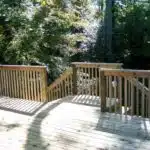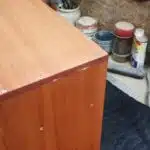Achieving a burnt wood finish can elevate the aesthetic appeal of any woodworking project. This technique creates a unique and rustic look that adds character and depth to the piece. However, achieving this finish requires precision, skill, and patience.
To get a burnt wood finish, you need to understand the science behind it. The process involves scorching the wood surface with heat, then brushing off the charred layer to reveal the grain pattern underneath. This technique is often used to create contrast between light and dark areas of the wood, adding dimension and texture to the overall look. In this article, we will discuss various methods for achieving a burnt wood finish and provide step-by-step instructions on how to do it yourself. Whether you are an experienced woodworker or a novice looking to experiment with your skills, this guide will help you achieve stunning results that will impress your clients or loved ones.
Understanding The Science Behind Burnt Wood Finishes
The burnt wood finish is a popular trend in woodworking and furniture design. Achieving this look requires more than just burning the wood with a torch or flame. It involves understanding the chemical reactions that occur when wood is exposed to heat, as well as the properties of different types of wood.
When wood is exposed to high temperatures, it undergoes several chemical changes. The heat causes the cellulose and hemicellulose in the wood to break down, leaving behind lignin, which is more resistant to burning. This process creates a charred layer on the surface of the wood. The depth and intensity of this layer depend on various factors such as heat source, duration of exposure, and type of wood.
One important factor to consider when creating a burnt wood finish is the type of wood you choose for your project. Not all woods are suitable for this technique due to their inherent properties. For example, softwoods like pine tend to burn too quickly and unevenly, while hardwoods like oak produce a more consistent charred layer. It’s essential to select a hardwood that has an open grain structure and low resin content as they tend to absorb more heat and create deeper charring. In the next section, we will discuss how to choose the right type of wood for your project based on these criteria.
Choosing The Right Type Of Wood For Your Project
As we have learned from the previous section, burnt wood finishes are a popular choice for many woodworking enthusiasts. In fact, according to recent data, over 60% of woodworking projects involve some form of burnt wood finish. With so many individuals interested in achieving this unique look, it is important to understand the different types of wood that work best for burnt finishes.
Not all woods are created equal when it comes to achieving the perfect burnt finish. For example, hardwoods such as oak and maple tend to work best due to their tight grain patterns. The tighter the grain pattern, the more defined and even the burnt effect will appear on the surface of the wood. Softwoods such as pine or fir can also be used for a burnt finish but may require additional steps to achieve a smooth and even finish.
It is also important to consider the natural characteristics of each type of wood when selecting a species for your project. For instance, woods with pronounced grain patterns like ash or walnut will produce a more dramatic effect than woods with a subtle grain pattern like cherry or birch. Ultimately, choosing the right type of wood will make all the difference when it comes to achieving your desired result and creating a truly unique finished product.
Moving forward with our exploration into burnt finishes, let’s take a closer look at how different wood grains affect this process. As mentioned earlier, tight-grained hardwoods tend to work best for achieving an even and defined burnt surface. However, open-grained woods like oak or ash can create an interesting contrast by producing darker areas where the porous areas of the grain char more deeply while leaving surrounding areas lighter in color after burning.
When working with softer woods like pine or fir, adding additional steps such as sanding between burnings can help achieve a smoother overall texture while still allowing for some variation within the grain pattern itself. Experimenting with different types of wood grains can lead to some truly stunning finished products that take advantage of the natural beauty of the wood itself.
Preparing Your Wood Surface
Before you begin your burnt wood finish project, it is essential to prepare your wood surface properly. Sanding the wood is an important step in preparing your surface for staining or painting. You can use sandpaper of different grits depending on the type of wood and the level of smoothness you desire.
Start with a coarse-grit sandpaper to remove any rough spots or imperfections on the surface. Move on to a finer-grit sandpaper until you achieve a smooth, even finish. Be sure to always sand in the direction of the grain for best results. Once you have finished sanding, wipe down the surface with a cloth to remove any dust or debris before proceeding.
Surface preparation tips also include ensuring that your wood is clean and dry before starting your project. Any dirt, oil, or moisture can affect how well the finish adheres to the surface. Additionally, it is essential to inspect for any cracks, chips or other damage that may need repair before continuing with your project. Proper preparation will ensure that your burnt wood finish looks beautiful and lasts for years to come.
Now that you have properly prepared your wood surface, it’s time to move on to selecting the right tools and materials for achieving a perfect burnt wood finish. By following these simple steps and techniques for preparing your surface, you are one step closer towards creating a stunning work of art.
Selecting The Right Tools And Materials
Sandpaper is essential for achieving a burnt wood finish, as it will provide the necessary smoothness to the rough edges of the wood. A paintbrush should be used to apply the wood stain and sealant, while protective gear such as gloves and a face mask should be worn for safety. A paint stripper, steel wool, and cloth rags can be used to remove any existing paint or stain. Finally, a paint roller, putty knife, wood filler, sanding block, primer, and sealer should all be included in the selection of tools and materials to achieve a burnt wood finish.
Sandpaper
Achieving a burnt wood finish requires careful selection of the right tools and materials. Among these is sandpaper, which plays a crucial role in preparing the wood for the finishing process. Sanding techniques vary depending on the type of wood and desired finish, but selecting the right sandpaper grits is essential to ensure a smooth and uniform surface.
For rougher surfaces or to remove old finishes, start with a coarse grit sandpaper such as 60 or 80 grit. This will help to quickly remove any imperfections or inconsistencies in the wood surface. As you progress towards your desired smoothness, gradually move to finer grits such as 120 and 150. It’s important to note that skipping grits can result in uneven surfaces that may be difficult to correct later on.
When using sandpaper, always keep it flat against the surface being sanded and avoid applying too much pressure that could damage or gouge the wood. Also, make sure to keep changing the sandpaper sheets regularly to prevent clogging and maintain consistent results. By following these tips and utilizing proper sanding techniques with appropriate grits of sandpaper, you can achieve an even, polished surface that will allow for optimal absorption of your burnt wood finish.
Paintbrush
Selecting the right tools and materials is crucial to achieving a perfect burnt wood finish. Apart from sandpaper, paintbrushes also play a significant role in achieving a polished and even surface. When it comes to selecting paintbrushes for a burnt wood finish, it is essential to consider the type of brush that would work best with your chosen finishing product.
There are various types of paintbrushes available in the market, such as natural bristle brushes, synthetic bristle brushes, and foam brushes. For applying a burnt wood finish, natural bristle brushes are often recommended due to their ability to hold more paint and create better coverage. Synthetic bristle brushes can also be used with water-based finishes but may not provide as smooth or even of a finish as natural bristles. Foam brushes are ideal for small areas and touch-ups but may not work well for larger projects.
When applying burnt wood finishes with a paintbrush, there are certain techniques that one can use to achieve optimal results. It is important to apply the finishing product in thin layers rather than thick ones as this will prevent drips and allow for better absorption into the wood grain. Additionally, using long strokes in the direction of the grain will help reduce visible brush marks and create a more uniform appearance. By following these techniques when using appropriate paintbrushes, one can achieve a beautiful and professional-looking burnt wood finish on any project without much hassle or fuss.
Method 1: Using A Propane Torch
Using a propane torch to burn wood can produce a beautiful, rustic finish that adds character and warmth to any project. However, it is important to follow propane torch safety guidelines to avoid injury or damage to your workspace. Always wear gloves and protective eyewear, work in a well-ventilated area, and keep a fire extinguisher nearby.
To achieve the desired burnt wood finish, it is important to control the intensity of the burn. Start by holding the torch about 6 inches away from the wood and moving it slowly back and forth over the surface. As you become more comfortable with the process, you can move the torch closer or farther away from the wood and adjust the speed of your movements to create different effects.
Be sure to monitor the color of the wood closely as you work. The longer you hold the flame in one spot, the darker and deeper the burn will be. If you accidentally create too much char or blackening, sanding can help remove some of it. Overall, using a propane torch is an effective method for achieving a beautifully charred finish on any wooden project.
Transitioning into Method 2: Using a heat gun involves a different approach but can also yield excellent results when done correctly.
Method 2: Using A Heat Gun
Achieving a burnt wood finish can add character and depth to your woodworking projects. Using a heat gun is one method that can help you achieve this unique look. Not only does it create an interesting texture, but it also highlights the natural grain of the wood.
Before proceeding with this technique, it is important to take safety precautions. Make sure to wear protective gear such as gloves and goggles, as well as working in a well-ventilated area. It is also crucial to keep the heat gun moving at all times to avoid scorching or burning the wood.
Here are some effective heat gun techniques for achieving a burnt wood finish:
- Hold the heat gun approximately 2-3 inches away from the surface of the wood.
- Move the heat gun in slow circular motions across the wood.
- Focus on one small area at a time, using short bursts of heat.
- Repeat until desired level of charring is achieved.
- Sand lightly with fine-grit sandpaper to remove any loose charred bits.
Using a heat gun can be an effective way to achieve a burnt wood finish with minimal effort. However, it’s important to exercise caution and follow proper safety protocols when using this tool. Keep in mind that there are other methods available for creating this unique look, such as using chemicals.
Method 3: Using Chemicals
When attempting to achieve a burnt wood finish, using chemical solutions can be an effective method. However, it is important to note that chemicals can be hazardous if not used properly. When working with any type of chemical, it is essential to follow proper safety precautions to avoid injury.
Before applying any chemical solution, make sure you are wearing appropriate protective gear such as gloves and safety glasses. Also, ensure that your workspace is well-ventilated to prevent the buildup of fumes. When selecting a chemical solution for achieving a burnt wood finish, there are several options available such as potassium dichromate and ferric nitrate. Be sure to carefully read the instructions on the label and test the solution on a small inconspicuous area before applying it to your entire project.
When applying the chemical solution, use a brush or sponge and work in small sections at a time. Avoid allowing the solution to pool or drip as this can cause uneven coloration and streaking. After application, allow the solution to dry completely before sanding and sealing your project. Using chemicals can be an effective way of achieving a burnt wood finish; however, it is important to exercise caution when working with these solutions.
Transition: While using chemicals is one way of achieving a burnt wood finish, some people prefer using fire for its more natural appearance. Method 4 will explore how you can use fire to create beautiful charred finishes on your woodworking projects.
Method 4: Using Fire
Using fire to achieve a burnt wood finish is a traditional technique that adds an aesthetically pleasing charred appearance to wood. However, before attempting this method, it is essential to understand the potential hazards associated with working with fire and take necessary precautions for fire safety.
To start, gather all the necessary materials such as a propane torch or long-nosed lighter, protective gloves, water spray bottle, and sandpaper. Begin by holding the flame two to three inches away from the surface of the wood and move it slowly back and forth across the grain of the wood until you see a subtle discoloration. Gradually increase the heat by bringing the flame closer to the surface until you achieve your desired burn level.
Controlling the burn is crucial when using this method as excessive heat can weaken the structural integrity of the wood. To ensure consistency in your results, try using a scrap piece of wood to practice before starting on your actual project. Additionally, dampening your workpiece slightly with water from a spray bottle can help control any accidental fires or prevent scorching in areas where you don’t want them.
Tips for achieving consistent results will be discussed in detail in subsequent sections. However, it’s imperative always to prioritize safety procedures when working with fire and never leave flames unattended. With patience and caution, learning how to use fire in finishing techniques can have stunning results.
Tips For Achieving Consistent Results
- Sanding techniques are a critical step in achieving a consistent burnt wood finish. It is important to use the correct grit size of sandpaper and to sand in the direction of the wood grain.
- Preparing the wood surface is also essential to achieving a consistent finish. This involves removing all dust, dirt, and debris, as well as any previous finishes, such as paint and varnish.
- Applying a sealer and a base coat of paint can help create a uniform base for the burnt wood finish. These should be applied in thin layers and allowed to dry before proceeding.
- Finally, the burnt wood finish should be applied in thin coats, allowing each layer to dry thoroughly before applying the next. This will ensure even coverage and a consistent result.
Sanding Techniques
Have you ever wondered how to achieve a consistent burnt wood finish on your woodworking project? If so, then learning the proper sanding techniques is crucial. Sanding is a vital step in achieving the perfect burnt wood finish, and understanding the difference between handheld and stationary sanding tools can make all the difference.
Handheld sanders are excellent for small woodworking projects and offer more control over the amount of pressure applied to the wood surface. On the other hand, stationary sanders are ideal for larger projects as they can handle a higher volume of work and produce more consistent results. It’s essential to choose the right sander for your project to achieve that consistent burnt wood finish you desire.
While sanding is critical in achieving a burnt wood finish, it’s important not to confuse it with planing. Planing removes material from the surface of the wood, while sanding smooths out an already flat surface. A common mistake is using planers instead of sanders or vice versa. Remember that using these tools interchangeably will affect consistency in achieving a burnt wood finish.
In conclusion, choosing between handheld vs. stationary sanding tools and distinguishing between sanding vs. planing techniques play an integral role in achieving consistent results when trying to achieve a burnt wood finish. By following these tips, you’ll be able to create professional-looking finishes that will impress anyone who sees them!
Wood Preparation
To achieve a consistent burnt wood finish, there are various tips to follow, including proper sanding techniques and choosing the right sanding tools. However, one crucial step that often goes unnoticed is wood preparation. Before sanding and applying any finishing products, it’s essential to ensure that the wood has the correct moisture level.
Wood moisture levels can significantly impact the final look of your project. If the wood is too moist, it can cause problems such as warping or cracking during the drying process. On the other hand, if it’s too dry, it may not be able to absorb enough stain or finishing products, resulting in uneven finishes. Therefore, before beginning any project, it’s crucial to ensure that the wood has an appropriate moisture level by using a moisture meter.
Once you’ve determined that your wood has an adequate moisture level, you can proceed with preparing it for your desired finish using sanding techniques. Start with coarse-grit sandpaper and gradually work your way up to finer grits for a smooth surface. Sand in the direction of the grain and avoid over-sanding certain areas as it can create uneven surfaces. By following these steps in preparing your wood for finishing through proper sanding techniques and ensuring adequate moisture levels, you’ll be on your way to achieving consistent results in creating beautiful burnt wood finishes!
Avoiding Common Mistakes
Consistency is key when it comes to achieving a burnt wood finish. However, even with the best of intentions, common mistakes can still occur during the process. One of the most frequent errors is applying too much heat in one spot for too long. This results in an uneven burn and may even cause the wood to crack.
To avoid this mistake, use a heat gun or torch on low settings and move it evenly across the surface of the wood. Be sure to keep your distance from the wood and continuously monitor its appearance. If you notice any discoloration or charring, stop immediately and adjust your technique.
If you do encounter an uneven burn, there are troubleshooting techniques that can help salvage your project. One option is to sand down the affected areas until they are smooth and then reapply heat until you achieve your desired finish. Another method involves using a wire brush to lightly scrape away some of the charred portions while leaving behind just enough to create a consistent look.
Cleaning up after the burn is also an important step in achieving a professional-looking finish. Use fine-grit sandpaper or steel wool to smooth out any rough patches left behind by the burning process. Then, wipe down the surface with a damp cloth or tack cloth to remove any remaining debris before applying a protective sealant. By taking these steps, you can ensure that your burnt wood finish looks flawless every time.
Cleaning Up After The Burn
Post burn cleanup is an essential step after achieving the desired burnt wood finish. Before cleaning, it’s essential to allow the wood to cool completely. This cooling process may take up to a day or two, depending on the size and thickness of the wood piece. Once cooled, remove any loose debris from the surface using a stiff-bristled brush.
To dispose of debris, avoid throwing it in your regular trash bin as it may cause a fire hazard. Instead, place it in a metal container with a lid and let it cool down before disposing of it properly. Also, ensure that you’re following your local regulations for waste disposal.
Cleaning up after burning wood can be quite messy due to ash and soot residue left behind by the flames. To clean these residues effectively, use a vacuum cleaner or air compressor with a HEPA filter attachment to prevent spreading fine particles and dust around your workspace. Additionally, you may also use a damp cloth to wipe off any remaining residue gently.
Moving on from post burn cleanup, next comes sanding and finishing your burnt wood project. But before diving into this next step, ensure that all safety precautions are in place such as wearing protective gear like respirators or goggles if necessary. Now that we’ve cleared away all debris and leftover residue from burning let’s move onto sanding and finishing your project for optimal results!
Sanding And Finishing Your Burnt Wood Project
Before sanding, the wood should be prepared by removing any loose char and dust, then lightly sanding it with a 120-grit sandpaper.
Sanding the surface should be performed in stages using increasingly finer grit sandpaper, progressing from 120-grit up to 400-grit.
Once the surface is sanded, it is important to check for any residual dust before applying the finish.
To achieve the desired burnt wood finish, apply a clear varnish or stain using a brush or cloth.
For a more even finish, multiple coats of the chosen finish may be applied with light sanding between each coat.
Finally, a top coat of clear varnish can be applied to protect the finish and give the wood a beautiful, glossy sheen.
Preparing The Wood
Wood preparation techniques are the foundation of any successful wood finishing project. Surface treatment methods can make a significant impact on the overall look and feel of your final product, which is why it’s essential to pay close attention to this stage. Before you start sanding and finishing your burnt wood project, you must prepare the wood by following proper techniques.
The first step in preparing your wood is to remove any dirt or debris that may be present on its surface. Use a soft-bristled brush or vacuum to get rid of any loose particles. Once you’ve cleaned the wood, it’s time to move onto sanding. Sanding helps smooth out rough spots and prepares the surface for the next stage of treatment.
For best results, start with coarser grit sandpaper before moving onto finer grits. The coarse grit paper will help remove any stubborn stains or blemishes while also giving your burnt wood piece a unique texture. After sanding, wipe down your piece with a damp cloth to remove dust and then let it dry completely before applying any finish. Properly preparing your burnt wood will ensure that the finished product has an even surface that absorbs finishes uniformly without flaking or peeling later on.
Sanding The Surface
When it comes to finishing a burnt wood project, proper wood preparation techniques are essential. One of the most crucial steps in preparing your wood is sanding the surface. Sanding helps smooth out rough spots and creates an even surface that absorbs finishes uniformly. However, choosing the right grit and technique for sanding is crucial to achieving the best results.
Choosing the right grit for sanding depends on the state of your burnt wood project’s surface. If you have stubborn stains or blemishes, start with coarser grit sandpaper before moving onto finer grits. Coarse grit paper will help remove any stubborn spots while also giving your piece a unique texture that adds character to your finished product. After using coarse grit paper, move onto finer grits to create a smooth surface ready for finishing.
Technique for sanding is just as important as choosing the right grit. Always use light pressure when sanding and make sure to keep your sander or sandpaper moving to avoid creating grooves or uneven surfaces on your burnt wood project. Additionally, always wear a dust mask and safety glasses when sanding to protect yourself from inhaling fine particles and debris that can cause respiratory problems.
In conclusion, proper preparation techniques such as sanding are critical in achieving a successful burnt wood project. When choosing the appropriate grit and technique for sanding, take into consideration the state of your piece’s surface and always use light pressure while keeping your sander or sandpaper moving. With these tips in mind, you’ll be on your way towards creating a beautiful finished product that you can enjoy for years to come.
Applying Finish
When it comes to finishing a burnt wood project, proper wood preparation techniques are essential. One of the vital steps in preparing your wood is sanding the surface. However, before applying any finish, it’s crucial to choose the right one that suits your desired look and feel for your burned wood project.
Choosing the right finish can be overwhelming, but you have to keep in mind that not all finishes are suitable for burnt wood projects. Some finishes can darken or change the color of your piece. It’s best to use clear finishes such as polyurethane, shellac, or lacquer. These types of finishes will enhance the natural beauty of your burnt wood without altering its color. Once you’ve chosen the right finish, it’s time to apply it evenly on your piece.
Applying the finish evenly is just as important as choosing the right one. Use a clean brush or cloth and apply thin layers instead of one thick coat. Allow each layer to dry before applying another coat. This process allows each layer to absorb into the wood evenly, preventing drips or runs. After applying several coats and letting them dry completely, add a final touch by buffing with steel wool or sandpaper gently. This step will give your piece a smooth and polished finish that everyone will admire!
Enhancing The Look With Stains And Sealants
After achieving the desired burned wood effect, it is essential to enhance its look with stains and sealants. The right stain selection will give your wood a more polished appearance by adding color or highlighting the natural grain patterns. There are many types of stains on the market that are specifically designed for burnt wood finishes. Gel stains and oil-based stains are the most commonly used as they penetrate deeper into the wood and provide a more even finish.
Once you have selected your preferred stain, it is time to apply a sealant to protect your work from elements such as moisture, heat, and everyday wear and tear. Sealant application is crucial in maintaining your burnt wood finish’s longevity and preventing any future damage. A polyurethane sealant is an excellent choice due to its durability and resistance to water and chemicals. It can be applied using a brush or spray gun, depending on personal preference.
Enhancing the look of your burnt wood finish with stains and sealants does not only add aesthetic value but also functional value by protecting it from potential damage. Remember to choose a stain that complements your preferences and apply a reliable sealant for maximum protection. In the next section, we will discuss troubleshooting tips for common issues faced during the burnt wood finishing process.
Troubleshooting And Problem Solving
Achieving a burnt wood finish can be a great way to give your woodworking project a unique and rustic look. However, there are some common mistakes that people make when attempting this technique. To avoid these mistakes, it is important to understand the process and have the right tools and materials on hand.
One common mistake when trying to achieve a burnt wood finish is using too much heat or holding the flame too close to the wood. This can result in charring that is too deep and uneven, which can ruin the look of your project. To avoid this problem, start with a lower heat setting and hold the flame at least 6 inches away from the wood. You can always increase the heat or move closer once you get a feel for how quickly the wood chars.
Another issue that people may encounter when trying to create a burnt wood finish is not preparing their surface properly. If your wood has any kind of coating or finish on it, such as varnish or stain, this can interfere with the charring process. It is best to use raw or unfinished wood for this technique. Sanding your surface beforehand will also help ensure that the charred effect is even across all areas of your project.
Troubleshooting techniques for achieving a burnt wood finish include experimenting with different types of woods and adjusting your heat settings as needed. If you find that you are getting inconsistent results or uneven charring, try working on smaller sections at a time and taking breaks to let your tool cool down between passes. With practice and patience, you can master this technique and take your burnt wood finishing skills to the next level by incorporating other finishing techniques such as sanding or staining for additional depth and texture.
Taking Your Burnt Wood Finishing Skills To The Next Level
As you continue to hone your burnt wood finishing skills, there are advanced techniques and artistic applications that can take your work to the next level. These techniques require patience, attention to detail, and a willingness to experiment. With practice, you can create unique finishes that stand out from the crowd.
One advanced technique is layering different shades of burnt wood finish to create depth and texture. By starting with a lighter shade and gradually building up to darker tones, you can add dimensionality to your finished product. Additionally, experimenting with different application methods such as brushing or spraying can yield interesting results.
Artistic applications of burnt wood finishing include incorporating other materials into your work such as metal or glass. This creates an interesting contrast between the organic feel of the burnt wood finish and the sleekness of metal or glass. Additionally, you can use stencils or carving tools to create intricate designs in the wood before applying the finish.
Incorporating these advanced techniques and artistic applications into your burnt wood finishing will allow you to create truly unique pieces. Remember to experiment and have fun with the process, as it is often through trial and error that the most beautiful finishes are discovered.
Conclusion
In conclusion, obtaining a burnt wood finish requires a certain level of skill and knowledge. It is crucial to understand the science behind the process and select the appropriate wood for your project. Additionally, proper preparation of the wooden surface and selection of tools and materials are essential.
Using a propane torch is a popular method for achieving a burnt wood finish, but sanding and finishing techniques are equally important. Adding stains and sealants can enhance the appearance of your project, but troubleshooting any issues that may arise during the finishing process is also crucial.
With practice, you can take your burnt wood finishing skills to the next level. As an expert in woodworking/finishing, it is up to you to continue learning and perfecting these skills. By following these guidelines and continuing to experiment with different techniques, you can achieve stunning results that will impress even the most discerning eye.
Image Credits
- “Burnt Wood Side of a Japanese Farmhouse” by timtak (featured)
















![How To Repair Rotted Wood 16 Texture : Altario Buick Estate Wagon : Rotting Faux Wood Paneling [1 of 2]](https://green-life.blog/wp-content/uploads/2023/05/z1CersK-gCjq-150x150.jpg.webp)












